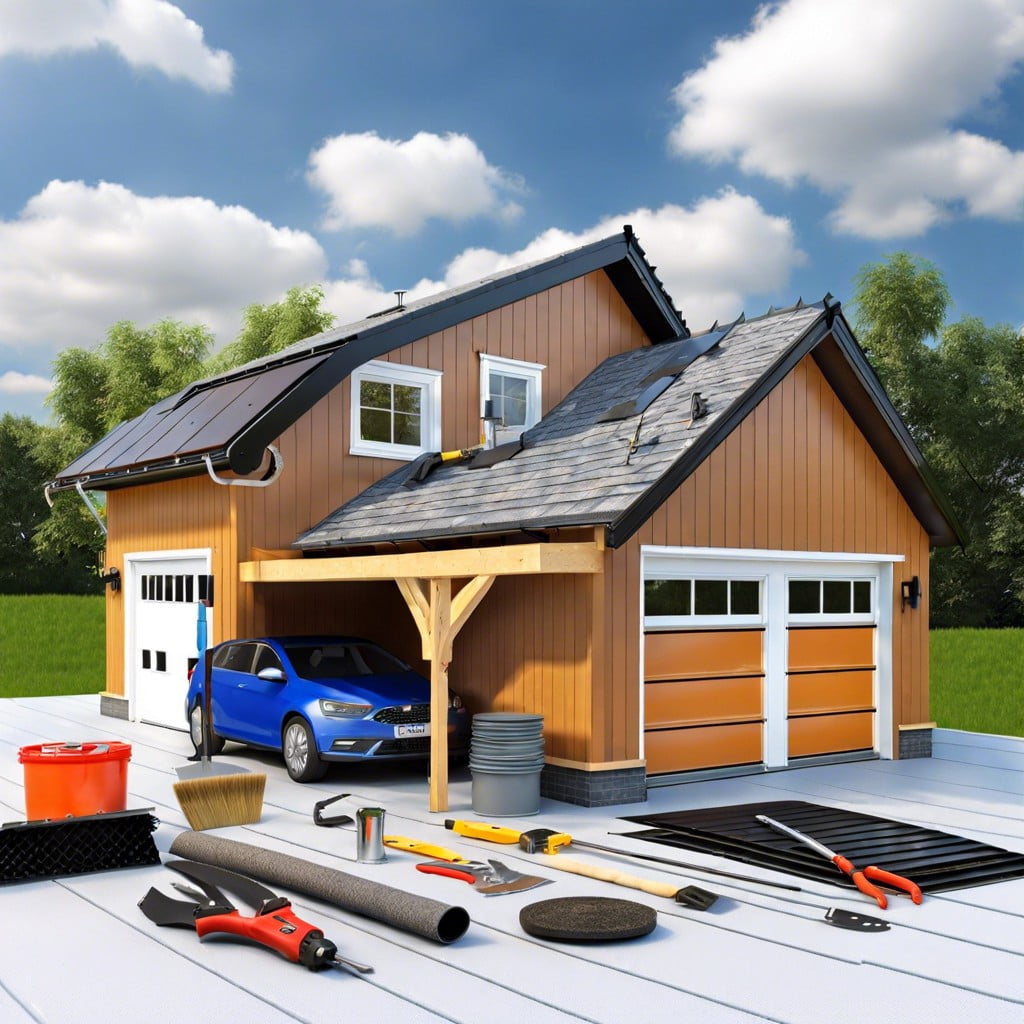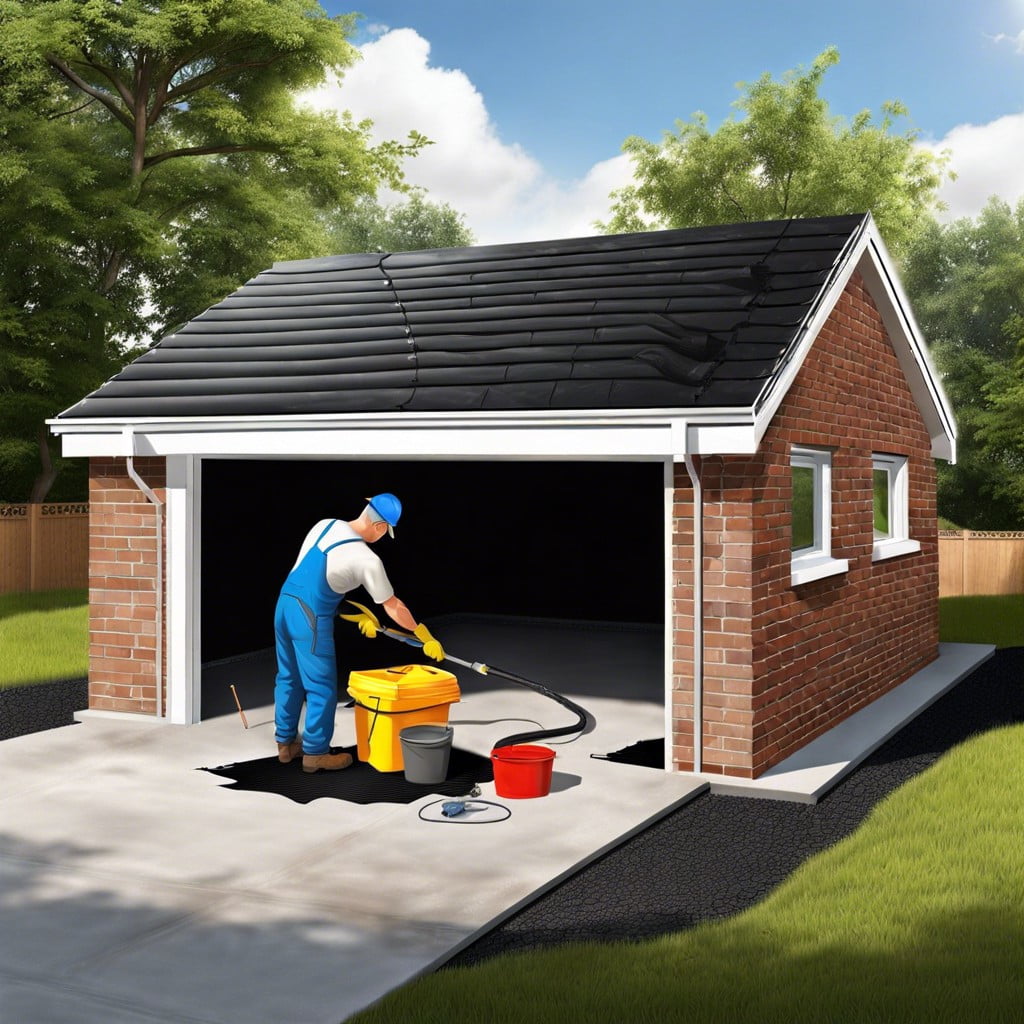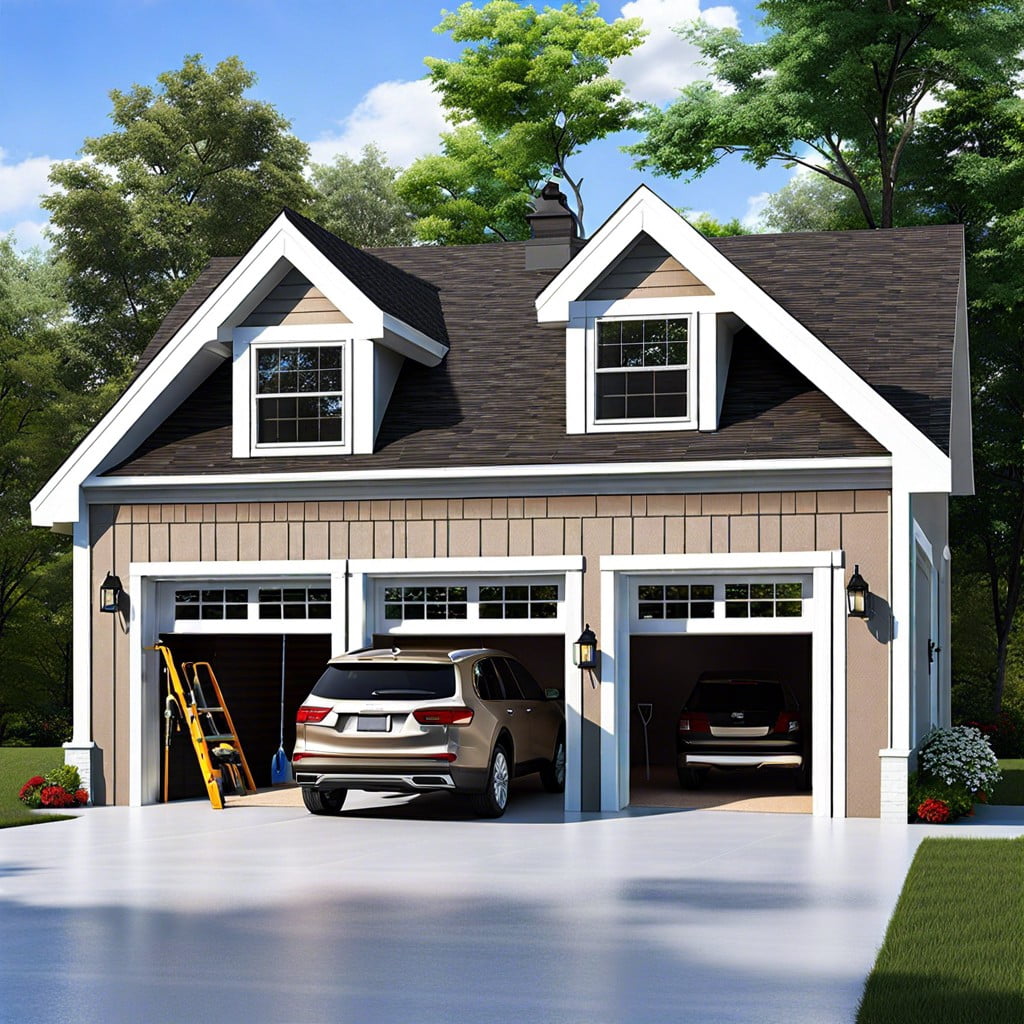Prompt handling of garage roof repair saves you from costly damages because your garage houses not only your cars but also important equipment and tools that need protection from the elements.
Key takeaways:
- Proper handling of garage roof repair prevents costly damages.
- Factors that cause garage roof leaks include age, weather damage, and improper installation.
- Garage roof repair cost varies based on the extent of damage and roofing material.
- Steps to fix a leaking garage roof include locating the source, replacing damaged shingles, and sealing roof features.
- Regular maintenance and inspections can extend the life of your garage roof.
What Causes Your Garage Roof To Leak?

Various factors can lead to a compromised garage roof that allows water to penetrate. Age is often the principal culprit; as roofing materials deteriorate over time, they lose their ability to repel water effectively. Damage from severe weather conditions, such as wind or hail, can also break down the integrity of the roofing materials. Even small branches or debris carried by the wind can create punctures or tears that become gateways for water intrusion.
Improper installation or previous repair work can also be a significant factor. If the roofing materials were not installed correctly, there might be gaps or weak spots that are prone to leaking. Additionally, flashing—the material that seals and protects the joints around roof projections like chimneys or vents—is crucial in guarding against leaks. If this flashing is damaged or was never properly installed, leaks are likely to occur.
Clogged or poorly maintained gutters can also contribute to leakage. When gutters and downspouts are blocked with leaves and debris, water can back up and pool on the roof, increasing the chances of seepage through any vulnerabilities in the roofing material.
Finally, condensation inside the garage can accumulate when there is poor ventilation. This buildup of moisture can mimic the appearance of a leaky roof, even though it originates from within the garage environment. Identifying the root causes of leakage is essential to determining the proper repair method.
Garage Roof Repair Cost

The price of repairing a garage roof varies largely depending on several factors—including the extent of the damage, the roofing material, and the cost of labor in your region.
A minor repair, such as sealing a few leaks, might cost as little as $150 to $300.
More significant repairs, such as fixing or replacing damaged shingles, can range from $350 to $1,400.
If the underlying structure has incurred damage or if a complete roof replacement is necessary, expenses could reach up to $4,000 or more.
It’s essential to obtain multiple quotes from reputable contractors to ensure a competitive price for your specific repair needs.
Remember, investing in a durable material and proper installation can lead to longer-lasting repairs and may ultimately save you money by preventing frequent issues.
How To Fix A Leaking Garage Roof

Begin by locating the source of the leak from inside the garage; water stains or mold can indicate the compromised area. On a dry day, examine the roof externally for damaged shingles, cracks, or holes.
For shingled roofs, remove the damaged shingles by lifting the edges of surrounding shingles and pulling out the nails. Slide in new shingles, securing them with roofing nails.
For flat roofs, clear debris and apply roofing cement to seal visible cracks or bubbles. For larger damaged areas, consider using a roofing patch that adheres to the roof’s material. Ensure the surface is clean and dry before applying the patch according to the manufacturer’s instructions.
Seal around roof features like vents or skylights with caulk or roofing tar to prevent water entry. Always overlap any repair materials to direct water away from the repair, ensuring a watertight seal.
Regularly replace old caulking and maintain the seals. After repairs, coat the roof with a waterproof sealer to provide an additional layer of protection against future leaks.
Remember, safety is paramount. Use a sturdy ladder, wear non-slip shoes, and consider using a safety harness when working on the roof. If the damage is extensive, the slope is steep, or you feel uncertain, consult a professional.
How To Extend The Life Of Your Garage Roof

Extending the life of your garage roof hinges on proactive care and maintenance. Regular inspections, ideally twice a year, can catch potential issues early.
Clean gutters and downspouts prevent water buildup and reduce the risk of leaks. Trimming overhanging branches limits debris accumulation and protects the roof from physical damage.
Apply a quality roof sealant to provide an additional protective layer against water infiltration. Replacing damaged shingles or panels promptly averts further deterioration.
Ensure proper ventilation to combat moisture buildup and temperature extremes that can weaken roofing materials over time. Lastly, address any structural problems immediately, as they can exacerbate roofing issues.
Is It Better To Patch Or Replace Your Garage Roof?
The decision between patching and replacing a garage roof hinges on several factors:
1. Extent of Damage: Minor leaks and isolated damage often call for patches. However, widespread or structural damage suggests the need for a complete roof replacement.
2. Age of the Roof: If the roof is nearing the end of its lifespan, which can vary depending on material but is typically around 20-25 years for asphalt shingles, investing in a new roof could be more cost-effective in the long run.
3. Future Plans: Consider your long-term plans for the property. If you’re planning to stay for many years, replacing an aging roof might be a wise investment, adding value and security to your home.
4. Budget: Patching is less expensive upfront, but if frequent repairs are needed, costs can accumulate, making replacement the more economically sound choice over time.
5. Energy Efficiency: New roofs offer better insulation and energy efficiency. If energy savings and indoor comfort are a priority, replacing an old, underperforming roof could be the way to go.
Weigh these factors carefully to determine the best course of action for your garage roof repair.
DIY Garage Roof Repair Vs. Professional Help
Deciding between tackling a garage roof repair on your own or calling in a professional hinges on several key considerations:
1. Complexity of Damage: Simple leaks may be manageable for DIY enthusiasts, whereas extensive damage typically requires professional expertise.
2. Tools and Equipment: Ensure you have the necessary tools and understand how to use them safely. Professionals have access to industry-grade equipment.
3. Safety: Assess the work’s safety; professionals are trained to handle heights and potential hazards.
4. Time Investment: DIY repairs can be time-consuming. Evaluate if you have the time to dedicate to the task.
5. Warranty and Insurance: Professional repairs often come with a warranty. DIY repairs could potentially void existing warranties or homeowner’s insurance policies.
6. Long-Term Costs: Immediate savings from DIY may be outweighed by long-term costs if the repair fails to address deeper issues that a professional would have identified.
7. Building Codes and Permits: Professionals are familiar with local building codes and acquiring necessary permits, which can be a complex part of the repair process.
Types of Roofing Materials for Your Garage
Selecting the right material is crucial for both durability and aesthetic appeal of your garage roof. Here are common options:
- Asphalt shingles are favored for their cost-effectiveness and ease of installation, making them a go-to choice for many homeowners.
- Metal roofing, known for its longevity and resistance to extreme weather, can include materials like steel, aluminum, and copper.
- Rubber roofing, typically in the form of EPDM (ethylene propylene diene terpolymer), offers a seamless and lightweight protective layer.
- Clay or concrete tiles add a Mediterranean flair to your structure, though they require a solid support due to their weight.
- Green roofing incorporates a layer of vegetation, which can provide excellent insulation and absorb rainwater, but may need additional structural support.
Each type of material has its pros and cons in terms of lifespan, insulation properties, and maintenance needs. Factor in your local climate, roof slope, and personal preferences to make the best choice for your garage.
Safety Precautions and Preparedness
Before embarking on any garage roof repair, prioritize safety. Personal protective equipment (PPE) such as gloves, safety goggles, and non-slip boots should be worn at all times to reduce the risk of injury. Additionally, ensure the ladder is sturdy and securely positioned to prevent falls. Using a harness tied to a stable structure can provide an extra layer of protection, especially on steeper roofs.
Also crucial is checking the weather forecast. Avoid working on the roof in wet or windy conditions as these can increase the risk of slipping or losing control of materials. Be mindful of power lines and keep a safe distance to prevent electrical hazards.
Ensure that all tools and materials are in good condition and within reach to prevent unnecessary movement on the roof, which could lead to accidents. Having a well-thought-out plan and a clear understanding of the repair process helps avoid unexpected issues that could compromise safety.
Lastly, if at any point the task seems overwhelming or beyond your skill level, do not hesitate to seek professional assistance. There is no substitute for the expertise and safety protocols that experienced roofers bring to a project.
When Should You Call a Roofing Company to Perform the Repair?
Recognizing the right time to seek professional assistance for your garage roof repair can save both time and money in the long run. If the damage extends beyond a few shingles or the leak is substantial, it’s wise to call in the experts. Complex issues such as structural damage, persistent leaks, or a roof nearing the end of its service life necessitate the skills of a proficient team.
Moreover, major repairs often involve warranties that only licensed contractors can provide. It is also crucial to consider your own safety; if the repair requires navigating steep slopes or handling hazardous materials, the risk is best left to those with the appropriate equipment and training. Furthermore, professional assessment can uncover less obvious issues that an untrained eye might miss, ensuring a comprehensive repair that will stand the test of time.
Future Maintenance and Regular Inspection
Ensuring your garage roof remains in top condition requires proactive measures. Set a schedule for routine examinations twice a year, typically in the spring and fall, to identify potential issues early.
Look for signs of wear such as cracked or missing shingles, damaged flashing, or pooled water. Keep gutters and downspouts clear to prevent water buildup. Trim overhanging branches that may damage the roofing material during harsh weather.
Should you discover minor issues, address them promptly to avoid more costly repairs down the line. Implementing consistent upkeep and acting swiftly at the first sign of trouble can significantly extend the lifespan of your garage roof.
FAQ
Can you repair a garage roof?
Yes, a garage roof can be repaired; however, if it's relatively old, replacing it might be more cost-effective in the long run, given the potential for multiple repairs.
What is the cheapest way to replace a garage roof?
The cheapest way to replace a garage roof is by using bitumen felt, a cost-effective flat roofing material, popular for its proven durability.
What is the cheapest way to cover a garage roof?
The most cost-effective method to cover a garage roof is by using bitumen roofing sheets due to their low maintenance, easy installation, and long-lasting lifespan.
What's the cheapest way to roof a garage?
The most cost-effective method to roof a garage is by using bitumen, making it an ideal choice for basic protection.
What essential steps should be followed in a DIY garage roof replacement?
DIY garage roof replacement requires key steps including surveying the current roof, selecting appropriate roofing materials, removing the old roof, putting on the new roof, and ensuring a proper finish for water drainage and durability.
How should one choose the right types of materials for garage roof repair?
Choosing the right materials for garage roof repair involves considering the existing roof material, local climate, intended longevity, and budget.
Are there any common mistakes to avoid while repairing a garage roof?
Yes, common mistakes to avoid while repairing a garage roof include neglecting safety measures, utilizing incorrect materials, not adequately preparing the surface, and ignoring underlying structural issues.